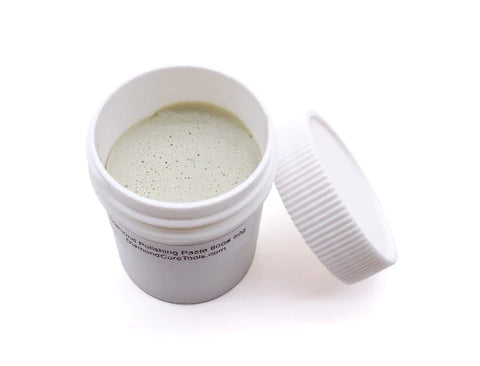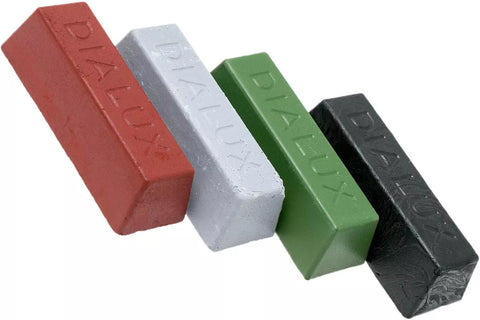1. Abrasive stropping compound purpose and function
To comprehend the function and significance of the abrasive stropping compound, it is imperative to have a clear understanding of the stropping process and its objectives.
Stropping serves as the concluding stage in treating blade bevels, following the sharpening and finishing processes on traditional abrasives like natural or synthetic sharpening stones. The primary goal at this stage is to eliminate micro burrs.
Another use of it is to occasionally strop the knife to keep it cutting edge sharp. This approach is beneficial when the tool, such as the knife in this case, can be honed on the leather surface, saving time and effort compared to a full sharpening process.
At times, users may find additional terms like polishing and honing confusing when it comes to knife maintenance. To polish the knife, means to refine the blade steel and remove minor visual imperfections and enhance the product's appearance, honing is a process of straightening out or pushing the cutting edge line back in alignment with a honing rod. In the context of knife sharpening, polishing serves no practical purpose, and honing is only used to keep the knife sharp until eventually it becomes dull and requires a proper sharpening.
In the process of stropping knives, it is crucial to prepare the bevels’ planes to the appropriate level to ensure that specific abrasives positively impact the steel of the blade. The surface of the bevels and the grit of the abrasive should be a good match to achieve the desired result. If you pick the wrong grit it can lead to insufficient impact or potential blunting of the blade's cutting edge.
Modern abrasives used for knife stropping typically consist of a variety of polishing products, including pastes and slurries.
2. Abrasive stropping compound types and their composition, advantages and disadvantages
Any paste or slurry used for knife stropping has two key technical characteristics. Firstly, the concentration of abrasive grit in the paste or emulsion is crucial. Secondly, the size of the abrasive grit plays a significant role in achieving a specific level of metal surface finishing.
The quality of finishing depends on the size of the abrasive grit, that said, the less differently sized grits the stropping compound has, the better finishing or stropping of the knife edge can be achieved.
Additional important characteristics to consider in knife maintenance are the physical and chemical properties of the abrasive grit. These include factors like the grit’s crushing speed and its chemical impact on the steel surface. While the former is well established, the latter remains somewhat controversial and requires further practical validation.
Furthermore, the quality of knife sharpening is directly impacted by the binder used in the paste or slurry.
It is worth noting that pastes and slurries were initially designed for for use with high-speed polishing wheels. However, for stropping and deburring tasks, a thick leather base is sufficient. To achieve a high-quality finish on knife cutting edges it is recommended to use hard and flat stones.
When applying paste to the strop, it is important not to exceed the size of a match head. The paste can also be diluted with different technical oils if needed. For emulsions and slurries on porous surfaces, it is advisable to adhere to the manufacturer's recommended guidelines for application.
2.1. Diamond paste
Diamond paste is a commonly utilized tool for knife finishing and stropping, known for its exceptional effectiveness. High-quality pastes containing a high concentration of diamonds come at a premium price, reflecting their superior performance. A key advantage of diamond paste is that the diamond grits have a longer lifespan compared to other abrasives.
Photo 1. Diamond paste
When using diamond paste for knife finishing and stropping, it is important to note that the treated surface area is small, and due to the diamond paste being highly abrasive, stropping with it requires careful handling and adherence to abrasive hygiene practices.
Such paste can be applied on various strops, as it adheres well even on smooth surfaces and maintains its consistency without drying out.
2.2. Cubic boron nitride (CBN) compounds
The key characteristic of these compounds is the cubic boron nitride grain itself, which boasts hardness comparable to diamond. The octahedral shape of the cubic boron nitride grit often yields more consistent and cleaner results than diamond pastes, which contributes to its higher cost.
Photo 2. Cubic boron nitride paste
These pastes are commonly used on high-speed steel, hardened steel with significant hardness, and various other metals.
In terms of application, these pastes follow the same principles as diamond pastes.
2.3. Aluminum oxide pastes
In these types of pastes, aluminum oxide (Al2O3) is typically in the form of white powder known as crystalline aluminum oxide or electrocorundum. This material is refractory, chemically resistant, and exceptionally hard. The powder exhibits high levels of hardness, heat resistance, and strength. While it is brittle in nature, it offers exceptional cutting capability during use.
Photo 3. Aluminum oxide paste
Electrocorundum ranks second only to diamond and boron nitride in terms of hardness. Aluminum oxide powder also possesses another advantageous property - it boasts a very fine grit size of approximately 1 micron, enabling high-precision finishing of cutting edges.
Pastes of this kind, produced by various companies, exhibit varying quality characteristics. Premium-quality pastes may contain up to 70% abrasive grits, with a mineral base often used as a binder. Despite the lower abrasive content in the rest of the mass, high-quality pastes offer better performance but are consumed at a faster rate.
Aluminum oxide-based pastes are affordable and widely available. It is advisable to assess the specific characteristics of these pastes to determine the most suitable option for your needs.
2.4. Chrome oxide pastes
Among all available pastes, polishing compounds containing chromium oxide are notably cost-effective and budget-friendly. Manufacturers typically offer this paste in a distinctive green hue; however, the quality of the abrasive grain may significantly vary.
Photo 4. Chrome oxide paste
Chromium oxide (Cr2O3) tends to degrade relatively quickly, necessitating frequent renewal. Additionally, the presence of larger grits in the composition can potentially damage the surface of the blade during sharpening, making it less suitable for precision blade work.
2.5. Abrasive slurry
In technical terms, a slurry refers to a substance consisting of a dispersed medium, such as water or oil, and solid abrasive particles that make up the dispersed phase.
2.5.1. Natural abrasive emulsions
Emulsions containing micro-powders of natural origin are manufactured using both water and oil bases.
Photo 5. Natural oil emulsion
It has been proven many times that it is possible to make even hard steels sharp with loose grits and that such emulsions can provide a fairly high level of finishing.
The outcomes obtained with these emulsions will vary based on the specific strops.
For instance, if you take a dense natural stone and dampen it with water, then take another stone and rub it against the surface of the first, you will see some slurry appearing on the surface. You can do the same with oil. The outcome will be consistent regardless of the steel used. Water-based finishing results in an aggressive, biting edge, while oil-based finishing provides a finer and more polished edge.
This suggests that the highest efficiency from natural abrasive slurries can be achieved when used with natural abrasive stones and either water or oil. Nevertheless, if desired or required, these types of slurries can also be used with strops made of various materials, whether soft or hard.
2.5.2. Synthetic abrasive emulsions
Synthetic abrasives commonly feature diamond grits in slurries found in products from various manufacturers, especially those designed for knife sharpening.
Photo 6. Diamond water emulsion
A notable characteristic that influences the application method of such slurries is the need to maintain consistent density across different layers. Additionally, the carrier of abrasive particles, serving as the dispersed medium, tends to dry out over time.
To address this issue, manufacturers have developed specialized materials that are fixed in a specific size on different carriers, absorbing the emulsion and bonding the diamonds together. This unique material is now referred to as nano-fabric.
The question arises whether it is appropriate to use such emulsions with leather strops or if their use with hard and smooth strops should be reserved for sharpening experts.
Photo 7. Synthetic oil emulsion
Some of these products are quite expensive, indicating the usage of high-quality diamond powder in their production.
Additionally, there are various abrasive slurries formulated with special oils and blends of different micro-powders. These slurries often contain compounds of aluminum oxide and silicon dioxide. Oily slurries are preferred for their non-drying properties, making them suitable for application on leather strops and even on metal stropping tools.
Water-based emulsions with similar properties are also available and can be used effectively with hard strops.
3. Conclusions and tips
If you are opting for the traditional method of stropping knives on a leather strop, here are some key points to consider:
- When using a household sharpener, increasing the angle by 1 degree during sharpening and finishing can not only remove a burr but also significantly reduce the biting of the cutting edge.
- When sharpening manually, applying excessive pressure can alter the blade angle with the surface. Prolonged use of such pressure can affect the shape of the cutting edge and turn it into a partially convex grind or roll over to the side. Finding the correct angle manually is a straightforward task: simply position the blade so you can feel the stone engaging with the cutting edge rather than slipping when you do sharpening motions. This tactile feedback builds muscle memory over time.
- Select the appropriate abrasive paste that can effectively handle the hardness of your blade.
- When honing manually, ensure the sharpening scratches pattern is not disrupted. Doing it in reverse could lead to intersecting scratches.
In practice, using three different grits of paste or slurry should be adequate, but the decision on how many different grits of material to use is ultimately up to you.











